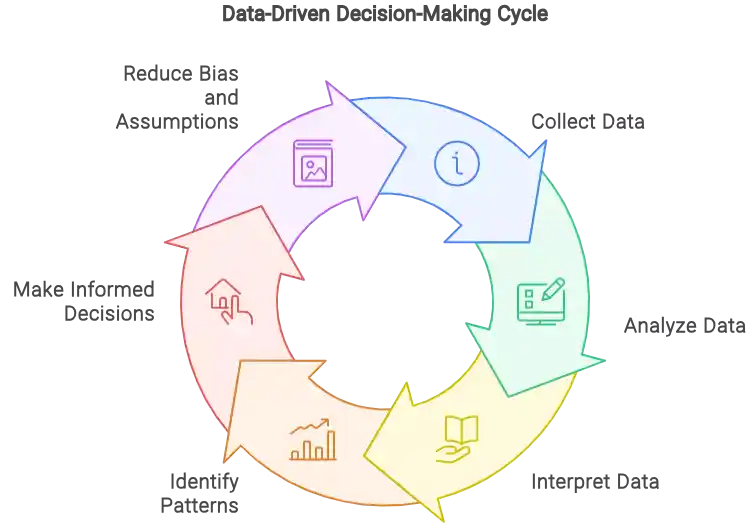Table of Contents
In today’s fast-paced business world, making the right decisions quickly and accurately is more important than ever. Data-driven decision making (DDDM) offers a powerful way for businesses to harness the vast amounts of data they generate and turn it into actionable insights. By relying on data rather than intuition or gut feeling, companies can improve their decision-making processes, leading to better outcomes and competitive advantages.
Transitioning to a data-driven approach may seem daunting, but with the right strategies and tools, any business can start making better decisions based on data. In this blog post, we will explore the benefits of data-driven decision making, how to implement it in your business, the tools you can use, and real-life examples of successful data-driven decisions. Whether you’re a small business owner or a corporate executive, you’ll find valuable insights to help you make more informed decisions.

Benefits of Data-Driven Decision Making
DDDM isn’t just a trendy buzzword; it’s a game-changer. Here’s how embracing it can propel your business forward:
- Sharper Decision-Making: Imagine having a crystal ball that unveils the potential outcomes of your choices. With DDDM, data analysis helps you identify trends, predict customer behavior, and assess risks. This empowers you to make informed decisions with greater confidence, minimizing the chance of costly missteps. Using Airtable makes this process easier by organizing and showing data in a way that helps you understand and act on it quickly.”
- Enhanced Customer Understanding: Your customers are the lifeblood of your business. DDDM allows you to analyze customer data like purchase history, website behavior, and survey responses. This paints a detailed picture of your customer base, enabling you to tailor your marketing strategies, product offerings, and overall customer experience to their specific needs and preferences.
- Improved Efficiency and Productivity: Data analysis can reveal areas where your operations are lagging. By identifying bottlenecks and inefficiencies, you can streamline processes, optimize resource allocation, and ultimately boost overall productivity. This translates to cost savings and a competitive edge.
- Data-Backed Innovation: DDDM fosters a culture of data-driven exploration. By analyzing market trends and customer feedback, you can identify potential opportunities for innovation. This can lead to the development of new products, services, or marketing campaigns that truly resonate with your target audience.
- Stronger Risk Management: Every business faces risks. DDDM equips you with the tools to proactively identify and mitigate potential threats. By analyzing historical data and industry trends, you can develop contingency plans and make informed decisions that safeguard your business from unforeseen challenges.
Implementing Data-Driven Decision Making
We’ve established the importance of setting clear goals and identifying relevant data. Now, let’s delve deeper into the practical aspects of implementing a data-driven decision making approach. Here’s a roadmap to guide you:
- Data Collection and Integration: Once you’ve identified the data you need, determine the best methods for collecting it. This might involve extracting data from existing systems like your CRM or website analytics platform, conducting surveys, or gathering customer feedback through social media channels. To gain unfiltered and unbiased insights, consider using an anonymous feedback collection tool. This enables businesses to capture honest opinions, helping to refine strategies and improve overall decision-making.
It’s crucial to establish a robust data integration strategy to ensure seamless data flow from various sources into a central repository. This has the potential to be either a data warehouse or a data lake hosted on the cloud. Data quality is paramount, so implement data cleaning procedures to remove inconsistencies and errors before analysis.
- Data Governance and Security: As you accumulate data, establish clear data governance policies. These policies dictate who has access to data, how it can be used, and how long it can be retained. This ensures responsible data handling and compliance with relevant regulations like GDPR or CCPA.
Data security should also be a top priority. Implement robust security measures like encryption and access controls to safeguard sensitive customer information.
- Building Your Data Team: The success of your data-driven decision making initiative hinges on having the right people in place. Consider building an in-house data analyst team or partnering with a data analytics consultancy.
Look for individuals with expertise in data analysis, data visualization, and communication. They should be able to translate complex data insights into actionable recommendations that resonate with business stakeholders.
- Communication and Collaboration: Data-driven decision making isn’t a siloed process. Foster open communication and collaboration between your data team and other departments like marketing, sales, and operations. Encourage data literacy across the organization so everyone can understand and leverage data insights effectively.

Tools for Data-Driven Decision Making
- Data Extraction and Transformation Tools: These data extraction tools automate the process of extracting data from various sources and transforming it into a format suitable for analysis e.g. converting complex XML to database and SQL. They can significantly streamline your data collection and integration process.
- Data Warehousing and Data Lakes: As mentioned previously, data warehouses provide a centralized storage location for structured data, while data lakes store both structured and unstructured data (like text, images, and videos). Consider your data storage needs and budget when choosing between these options. For businesses looking to optimize data center management, leveraging colocation solutions can streamline operations and enhance data storage efficiency.
- Advanced Analytics Platforms: These platforms offer sophisticated analytical capabilities beyond basic visualization tools. They may include features like predictive analytics, machine learning, and data mining, allowing you to uncover deeper insights and make more informed predictions.
- Collaboration and Communication Tools: Facilitate seamless communication and data sharing between your data team and other departments. Utilize collaboration platforms, data visualization dashboards, and reporting tools that cater to a non-technical audience.
Remember, the ideal DDDM toolkit depends on your specific needs and budget. Start with essential tools like data visualization software and gradually expand your arsenal as your DDDM practice matures.
Real-Life Examples of Successful Data-Driven Decisions
Netflix: Personalized Recommendations
Netflix is a prime example of a company that has successfully implemented data-driven decision making. The streaming giant uses data to personalize content recommendations for its users, enhancing the viewing experience and driving customer engagement. By analyzing user behavior, such as viewing history and preferences, Netflix’s recommendation engine can suggest shows and movies that are most likely to appeal to each user.
This data-driven approach has been highly effective, with personalized recommendations accounting for a significant portion of Netflix’s viewing activity. By leveraging data to understand their audience better and deliver tailored content, Netflix has maintained its position as a leader in the streaming industry.
Amazon: Optimizing Supply Chain Operations
Amazon is another company that excels in data-driven decision making. The e-commerce giant uses data to optimize its supply chain operations, ensuring that products are delivered to customers quickly and efficiently. By analyzing data on inventory levels, customer demand, and shipping logistics, Amazon can make real-time adjustments to its supply chain, reducing costs and improving delivery times.
Amazon’s data-driven approach extends to its recommendation system, which suggests products to customers based on their browsing and purchase history. This personalized shopping experience has contributed to Amazon’s success by driving higher sales and customer satisfaction.
Overcoming Challenges in Data-Driven Decision Making
Data Quality and Integrity
One of the biggest challenges businesses face when implementing data-driven decision making is ensuring data quality and integrity. Incorrect or missing information can result in wrong assumptions and bad choices. To overcome this challenge, businesses must establish robust data governance practices, including data validation, cleansing, and regular audits.
Investing in data management tools and technologies can also help improve data quality. These tools can automate data collection and processing, reducing the risk of human error and ensuring that data is accurate and up-to-date. By prioritizing data quality, businesses can make more reliable and effective data-driven decisions. Businesses can leverage proxy locations to ensure accurate data collection and processing.
Data Security and Privacy
Data security and privacy are critical considerations in data-driven decision making. Businesses must ensure that their data is protected from unauthorized access and breaches, which can have severe consequences for both the company and its customers. Implementing strong security measures, such as encryption, access controls, and regular security assessments, is essential to safeguarding data.

Additionally, businesses must comply with data privacy regulations, such as GDPR and CCPA, which govern how personal data is collected, stored, and used. By adhering to these regulations and being transparent about data practices, companies can build trust with their customers and avoid legal and reputational risks.
The Future of Data-Driven Decision Making
Artificial Intelligence and Machine Learning
The future of data-driven decision making is closely tied to advancements in artificial intelligence (AI) and machine learning (ML). These technologies enable businesses to analyze vast amounts of data more quickly and accurately, uncovering insights that would be impossible to detect through manual analysis. AI and ML can also automate decision-making processes, allowing companies to respond to changing conditions in real-time.
For example, predictive analytics powered by AI can help businesses forecast demand, optimize pricing strategies, and identify potential risks. As AI and ML technologies continue to evolve, their applications in data-driven decision making will expand, offering even greater opportunities for businesses to improve their operations and outcomes.
Data Democratization
Another key trend in the future of data-driven decision making is data democratization. This involves making data accessible to employees at all levels of the organization, empowering them to use data in their decision making processes. By breaking down data silos and providing user-friendly tools, businesses can ensure that data-driven insights are integrated into every aspect of their operations.
Data democratization also involves fostering a culture of data literacy, where employees are equipped with the skills to interpret and analyze data effectively. As more businesses embrace data democratization, the ability to make data-driven decisions will become a core competency, driving innovation and competitive advantage.
Conclusion
Data-driven decision-making is a powerful approach that can transform how businesses operate and succeed. By leveraging data to inform decisions, companies can improve accuracy, efficiency, and customer satisfaction, leading to better outcomes and a competitive edge. Implementing data-driven decision-making requires a commitment to building a data-driven culture, investing in the right tools and technologies, and overcoming challenges related to data quality and security.
As we look to the future, advancements in AI and machine learning, as well as the growing trend of data democratization, will continue to shape the landscape of data-driven decision making. Businesses that embrace these trends and prioritize data-driven strategies will be well-positioned to thrive in an increasingly data-centric world.